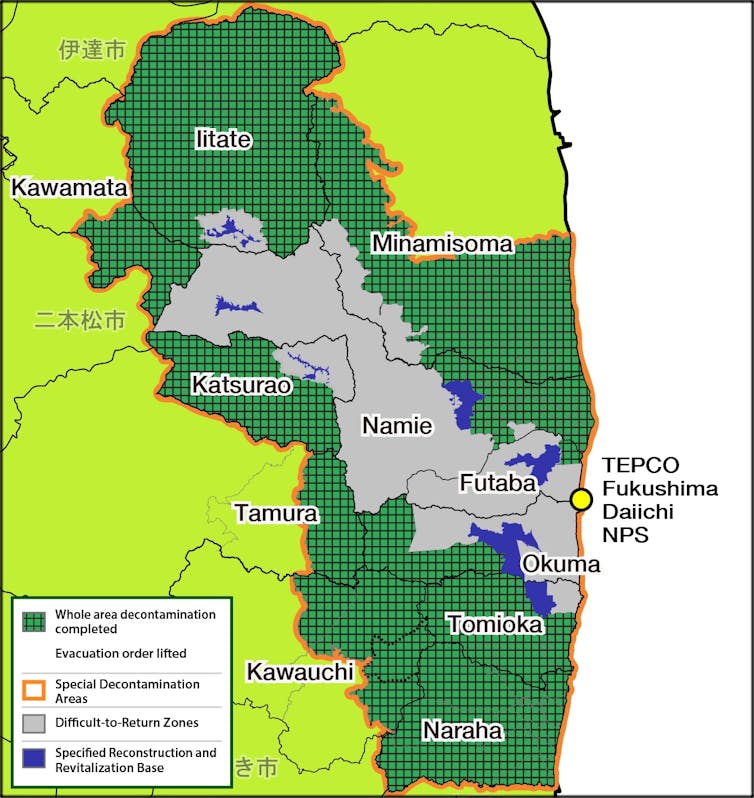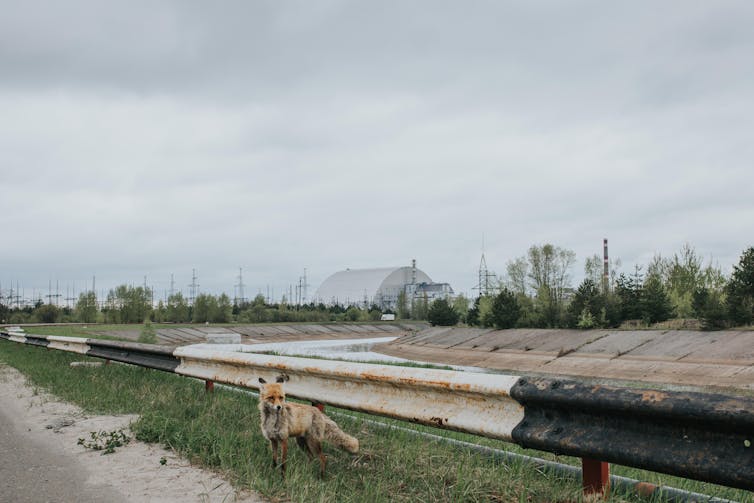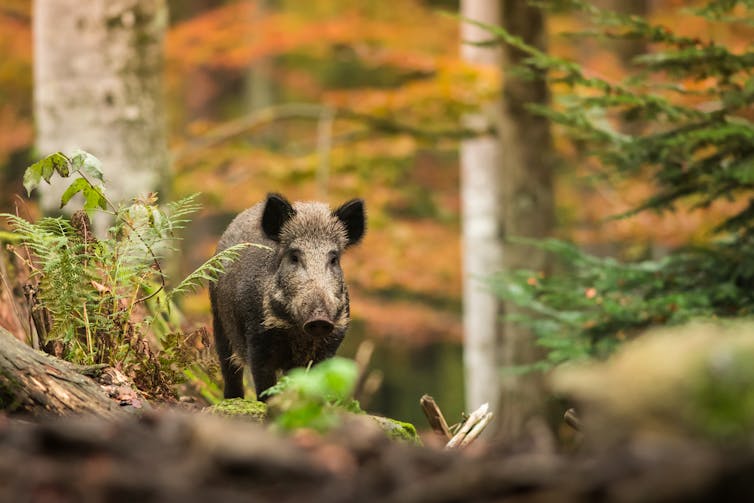The Chernobyl and (to a lesser extent) Fukushima nuclear accidents contaminated large areas of land with low-level radioactivity. After both accidents, huge efforts were taken to decontaminate the affected areas.
But a recent study at Fukushima raises doubts about whether these decontamination efforts were worthwhile. Less than one-third of the population has returned to the evacuated zones and extensive areas of forest in the region remain contaminated.
Following the accident at Fukushima Daiichi in 2011, approximately 1,100 square kilometres were evacuated, resulting in the relocation of more than 100,000 people from their homes. A contaminated area about eight times larger remained inhabited, albeit subject to continuous radiation monitoring.
Read more: Fukushima: ten years on from the disaster, was Japan's response right?
The dominant source of radiation exposure for people stemmed from gamma rays emitted by contaminated soils, pavements, roads and buildings. The objective of the decontamination operation was to ensure that the general public received an annual dose from Fukushima’s radioactivity of less than 1,000 microsieverts (µSv) above the natural background level. The average natural radiation dose in Japan stands at 2,200 µSv per year.
Radiocaesium, which is the most important long-lived radioactive element emitted by the accident in terms of radiation dose, adheres to soil particles very strongly. Consequently, the decontamination of agricultural land primarily involved removing the top 5cm of soil. In urban areas, decontamination efforts entailed the removal of topsoil from sports fields, as well as sandblasting or pressure washing hard surfaces, and pressure washing drains and gutters.
These efforts reduced doses by about 60% in residential areas and farmland, allowing people to return to their homes in a large part of the evacuated area. This is a far cry from Chernobyl, where extensive decontamination initiatives were ultimately abandoned, leaving huge evacuated areas that remain empty to this day. But was undertaking decontamination in Fukushima worthwhile?

Costs and benefits
Decontaminating the land in Fukushima has cost tens of billions of dollars. The process has, unfortunately, also caused substantial radiation exposure for the workers involved, and has generated huge amounts of radioactive soil waste. But the question of whether to decontaminate land is complex and only partially related to scientific evidence.
On the one hand, decontamination provides reassurance that radiation is being “cleaned up” and that doses are being reduced. But it can also give the impression that low-level radiation is more dangerous than it actually is.
Dose rates were not dangerously high in many areas of Fukushima that were subject to decontamination. In fact, doses were relatively low in the first year following the accident (less than 12,000 µSv), and these levels decreased significantly in subsequent years.
These levels fall within the natural range people are exposed to from radioactivity in rocks, soils, building materials and cosmic radiation worldwide (typically between 1,000 µSv and 10,000 µSv per year, but sometimes higher).
On balance, I think the reassurance that contamination was being cleaned up was valuable in many areas where people remained living. Decontamination also allowed agricultural land to be returned to productive use more quickly. However, the process of removing topsoil had the side effect of damaging soil fertility.
Accidental rewilding
In the evacuated zone where dose rates were around ten times higher, it’s less clear that decontamination was beneficial. Only 30% of people have returned to their homes in the decontaminated part of this area and much of the land in the most contaminated so-called “difficult to return zone” remains abandoned.
A better option may have been to declare most of this zone a nature reserve and allow managed rewilding of the area. Rewilding is happening to a large extent anyway, as it has at Chernobyl. It would also have avoided decontamination workers being exposed to radiation and allowed more financial support to help people relocate.
But this is a complex decision that needs to consider the views of many stakeholders, not least the evacuated people themselves.

Fukushima’s contaminated forests
The land in and around the region’s towns and villages has generally been decontaminated effectively. However, much of the Fukushima Prefecture (71%) is covered by forest. Most of this forest remains contaminated.
The persistence of radiocaesium in ecosystems, particularly in forests, has been known for many decades. Globally, radiocaesium levels in wild foodstuffs such as mushrooms, edible plants, game animals and freshwater fish tend to be higher than those found in agricultural systems.
Wild boar in certain regions of Germany, for instance, still exhibit radicaesium levels exceeding consumption limits as a consequence of both Chernobyl and historical nuclear weapons testing. Restrictions on the consumption of forest products have lasted for decades following the Chernobyl incident. And they are expected to persist in many forested areas of Fukushima too.
Radiocaesium lingers in forests due to the prevalence of organic soils and the absence of fertiliser application. Low nutrient levels facilitate the absorption of radiocaesium by plants. This is mainly attributed to radiocaesium’s chemical similarity to potassium, a crucial plant nutrient.
Forests do pose a wildfire risk. There have been many forest fires in the vicinity of Chernobyl since the accident. But radiation doses from smoke inhalation are extremely low, even for firefighters, and the fires have not significantly redistributed radioactivity.

There are no easy answers regarding clean up after a nuclear accident. Japan has made huge and often successful efforts to reduce radiation doses and reassure people living in or returning to the affected areas. But low-level radiation remains everywhere, particularly in forests.
We need to remember, though, that the radiation doses are almost always very low. The biological effects of radiation from nuclear accidents – primarily DNA damage – are the same as those from the natural radiation we are all exposed to from the food we eat and in our surrounding environment. While the dose rates for workers during an accident can be extremely high, those from radiation in the environment are low in the longer term.
Millions of people worldwide receive higher annual natural radiation doses than the residents of the Fukushima zones without even worrying about it.

Don’t have time to read about climate change as much as you’d like?
Get a weekly roundup in your inbox instead. Every Wednesday, The Conversation’s environment editor writes Imagine, a short email that goes a little deeper into just one climate issue. Join the 20,000+ readers who’ve subscribed so far.
Jim Smith is the founder and a Director of The Chernobyl Spirit Company, a social enterprise producing spirits from crops grown in areas affected by Chernobyl. Profits got to support Chernobyl affected areas in Ukraine. More than 5 years ago Jim did small consultancy contracts on behalf of his University for various organisations including the Japan Atomic Energy Agency. He has previously had a grant from the UK Natural Environment Research Council, part funded by Radioactive Waste Management Limited. He currently has no relevant external funding and does not do external consultancy.
This article was originally published on The Conversation. Read the original article.







